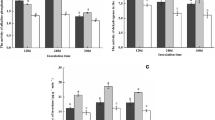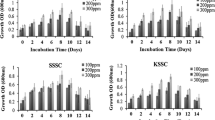Abstract
Soil samples, collected after the fire operations at agricultural sites under shifting cultivation in northeast India, were subjected to physico-chemical and microbial analysis. The fire affected various physico-chemical properties of the soil. Significant differences in pH and electrical conductivity were recorded in soil of fired and fallow plots. Significantly higher amounts of total organic carbon and nitrogen were estimated in fallow plots as compared to the fired. Difference in total phosphates was not significant. The fire operations resulted in stimulation of microbial communities. The bacteria were the most affected group followed by actinomycetes and fungi, respectively. The bacterial and actinomycetes counts were significantly higher in fired plots as compared to the fallow plots. The representative bacterial species recovered from the ‘fired plots’ belonged to the genus Bacillus and Pseudomonas. 16S rRNA analysis revealed their maximum similarity with B. clausii, B. licheniformis, B. megaterium, B. subtilis, B. thuringiensis, P. aeruginosa and P. stutzeri. Most of these species were found to be positive for phosphate solubilization and antagonism in plate based assays. In view of the importance of Bacillus and Pseudomonas species in plant growth promotion and biocontrol, recovery of these species after fire operations is indicative of the microbiological merit of shifting cultivation.


Similar content being viewed by others
References
Anderson JM, Ingram JSI (1993) Tropical soil biology and fertility. CAB International, Nairobi, Kenya
Balser TC, Firestone MK (2005) Linking microbial community composition and soil processes in a California annual grassland and mixed-conifer forest. Biogeochem 73:395–415
Benson HJ (1990) Microbiological applications: a laboratory manual in general microbiology. Wm. C. Brown Publishers, USA
Bisset J, Parkinson D (1980) Long term effects of fire on the composition and activity of the soil microflora of a subalpine, coniferous forest. Can J Bot 58:1704–1721
Chaurasia B, Pandey A, Palni LMS, Trivedi P, Kumar B, Colvin N (2005) Diffusible and volatile compounds produced by an antagonistic Bacillus subtilis strain cause structural deformities in pathogenic fungi in vitro studies. Microbiol Res 160(1):75–81
Choudhary D, Sundriyal RC (2003) Factors contributing to the marginalization of shifting cultivation in north-east India: micro scale issues. Outlook Agric 32:17–28
Deka HK, Mishra RR (1983) The effect of slash burning on soil microflora. Plant Soil 73:167–175
Ekinci H (2006) Effect of forest fire on some physical, chemical and biological properties of soil in Canakkale, Turkey. Int J Agric Biol 8(1):102–106
Ghosh PK, Saha R, Gupta JJ, Ramesh T, Das A, Lama TD, Munda GC, Bordoloi JS, Verma MR, Ngachan SV (2009) Long term effect of pastures on soil quality in acid soil of North East India. Aust J Soil Res 47(4):372–379
Giardina CP Jr, Sanford RL, Dockersmith IC (2000) Changes in soil phosphorus and nitrogen during slash-and-burn clearing of a dry tropical forest. Soil Sci Soc Am J 64:399–405
Hamman ST, Burke IC, Stromberger ME (2007) Relationships between microbial community structure and soil environmental conditions in a recently burned system. Soil Biol Biochem 39:1703–1711
Lugtenberg BJJ, Kamilova F (2009) Plant growth promoting rhizobacteria. Ann Rev Microbiol 63:363–383
McGonigle T, Chambers ML, White JW (2005) Enrichment over time of organic carbon and available phosphorus in semiarid soil. Soil Sci Soc Am J 69:1617–1626
Oke DO (2007) Growth of short rotation Cajanus cajanus fallow and its impact on a degraded alfisol. Int J Nat Eng Sci 1(3):1–4
Paul M, Paul PP (2009) Beneficial effects of shifting cultivation (jhum). Curr Sci 96(1):10
Ramakrishnan PS (2009) Linking traditional ecological knowledge systems with modern approaches. In: Sharma E, Khadka I, Shakya B (Guest eds) Biodiversity and climate change. ICIMOD, Kathmandu, Nepal, pp 16–18
Romanya` J, Casals P, Vallejo VR (2001) Short-term effects of fire on soil nitrogen availability in Mediterranean grasslands and shrublands growing in old fields. For Ecol Manag 147:39–53
Saitou N, Nei M (1987) The neighbor-joining method: a new method for reconstructing phylogenetic trees. Mol Biol Evol 4:406–425
Sambrook J, Fritsch EF, Maniatis T (1989) Molecular cloning: a laboratory manual, 2nd edn. Cold Spring Harbor, NY
Senthilkumar K, Manian S, Udaiyan K (1997) The effect of burning on soil enzyme activities in natural grasslands in southern India. Ecol Res 12(1):21–25
Sharma GD (1980) Effect of fire on soil microorganisms in a Meghalaya pine forest. Folia Microbiol 26(4):321–327
Singh RK, Srivastava RC, Mukherjee TK (2009) Community-based sustainable natural resources management and development in Northeast India. Curr Sci 96(1):19–23
Tangjang S (2009) Traditional slash and burn agriculture as a historic land use practice: a case study from the ethnic notes in Arunachal Pradesh, India. World J Agric Sci 5(1):70–73
Thompson JD, Gibson TJ, Plewniak F, Jeanmougin F, Higgins DG (1997) The Clustal X windows interface: flexible strategies for multiple sequence alignment aided by quality analysis tools. Nucleic Acids Res 24:4876–4882
Tilak KVBR, Ranganayaki N, Pal KK, De R, Saxena AK, Nautiyal CS, Mittal S, Tripathi AK, Johri BN (2005) Diversity of plant growth and soil health supporting bacteria. Curr Sci 89:136–150
Tripathi OP, Pandey HN, Tripathi RS (2009) Litter production, decomposition and physico-chemical properties of soil in 3 developed agroforestry systems in Megahalaya, North East India. Afr J Plant Sci 3(8):160–167
Yates C, Gilling MR, Davison AD, Altavilla N, Veal DA (1997) PCR amplification of crude microbial DNA extracted from soil. Lett Appl Microbiol 25:303–307
Zhou L, Huang J, Lu¨ F, Han X (2009) Effects of prescribed burning and seasonal and interannual climate variation on nitrogen mineralization in a typical steppe in Inner Mongolia. Soil Biol Biochem 41:796–803
Acknowledgements
The Ministry of Environment and Forests, Govt. of India, New Delhi, is thanked for financial support. Help received from Dr Yogesh S Shouche, NCCS, Pune, is gratefully acknowledged for extending the sequencing facility.
Author information
Authors and Affiliations
Corresponding author
Rights and permissions
About this article
Cite this article
Pandey, A., Chaudhry, S., Sharma, A. et al. Recovery of Bacillus and Pseudomonas spp. from the ‘Fired Plots’ Under Shifting Cultivation in Northeast India. Curr Microbiol 62, 273–280 (2011). https://doi.org/10.1007/s00284-010-9702-6
Received:
Accepted:
Published:
Issue Date:
DOI: https://doi.org/10.1007/s00284-010-9702-6




